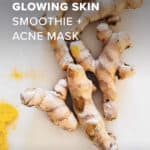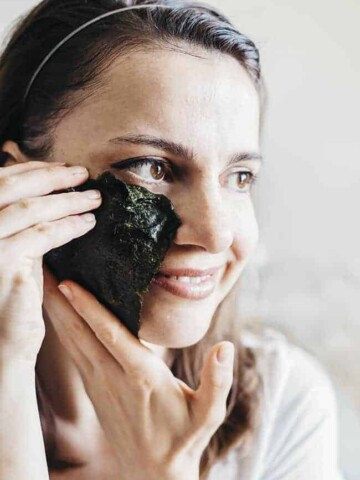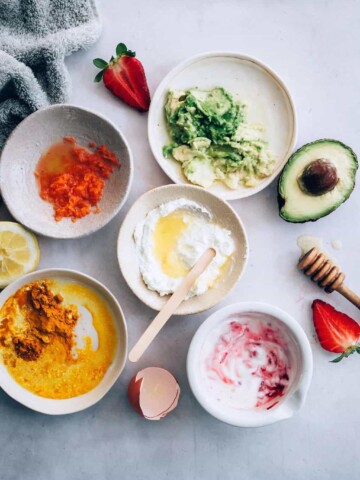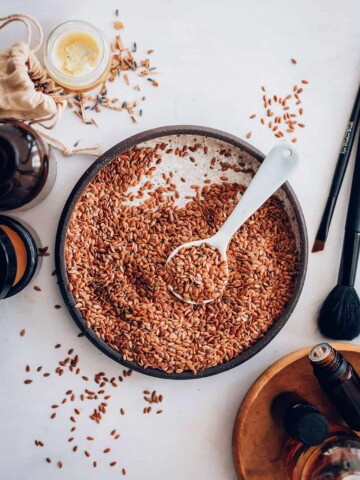Get nine effective ways to incorporate turmeric into your skincare routine to help tackle acne breakouts. From DIY face masks to soothing spot solutions, these turmeric treatments are both easy to prepare and backed by the science of turmeric's anti-inflammatory, antibacterial, and antioxidant properties.
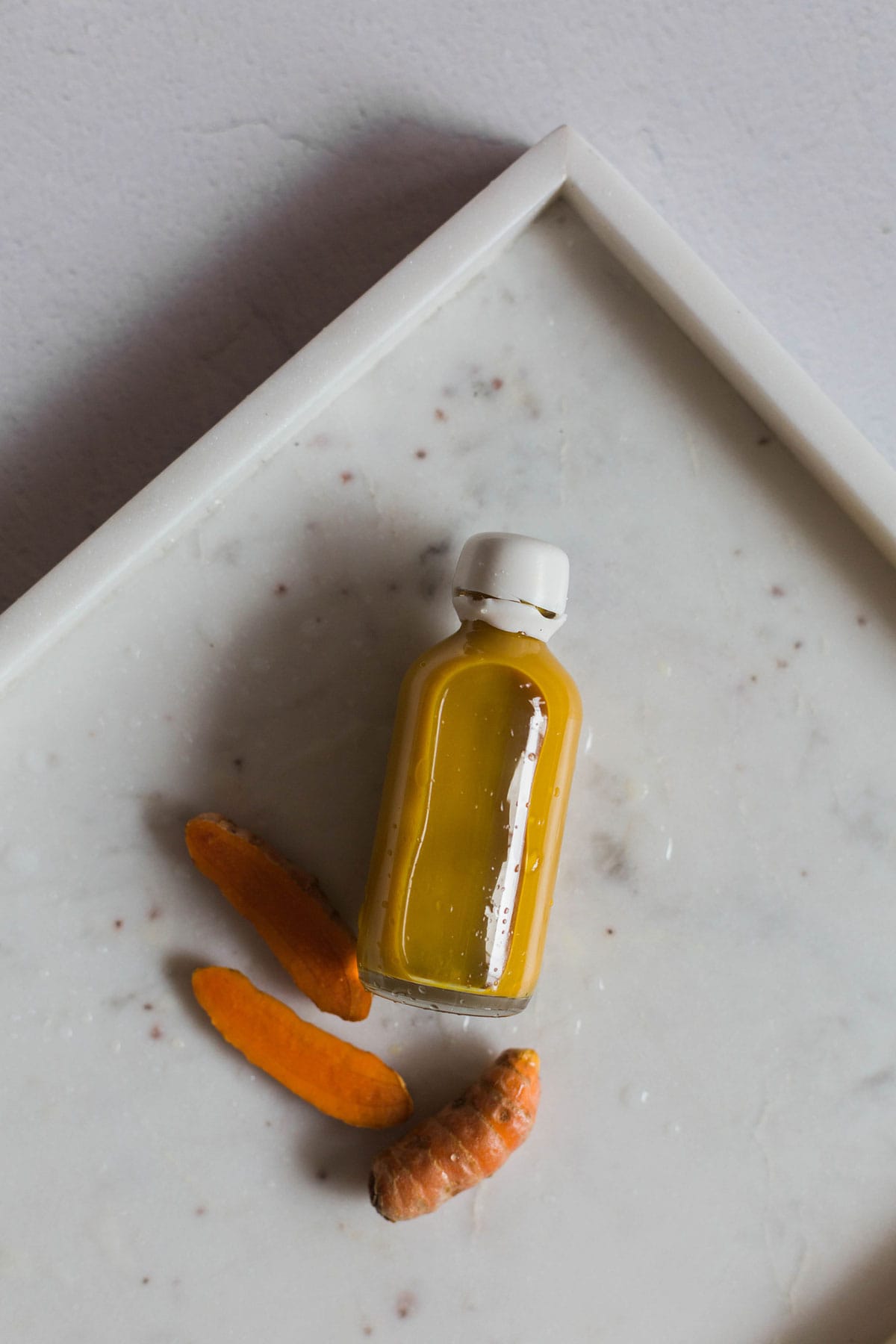
Turmeric has become a popular (dare I say trendy?) ingredient lately in health and beauty. Along with its numerous health benefits, you often hear the word glowing associated with turmeric. And who doesn’t want glowing skin, right? Here are 9 easy ways to use turmeric for acne.
Jump to:
- Why Use a Turmeric Mask for Acne?
- 1. Fight Bacteria with Turmeric + Apple Cider Vinegar
- 2. Even Out Skin Tone with Turmeric + Baking Soda
- 3. Calm Redness with Turmeric + Coconut Milk
- 4. Beat Blemishes with Turmeric Essential Oil
- 5. Erase Discoloration with Turmeric + Yogurt
- 6. Zap Zits Overnight with Turmeric + Tea Tree
- 7. Soothe Inflamed Skin with Turmeric + Aloe
- 8. Unclog Pores with Turmeric + Oatmeal
- 9. Maintain Clear Skin with Turmeric + Neem Oil
Why Use a Turmeric Mask for Acne?
This golden-hued spice has actually been around since ancient times, dating back some 4,000 years! It was used for a myriad of medicinal and religious purposes in South Asia, according to the book Herbal Medicine: Biomolecular and Clinical Aspects.
Acne is now understood to be primarily an inflammatory condition triggered by certain internal and external factors [source]. Turmeric’s most active component, curcumin, is a powerful anti-inflammatory [source], so it has the potential to reduce redness and swelling in existing pimples.
It is also antimicrobial, which helps to fight one of the external triggers—bacteria [source]. Additionally, turmeric is an antioxidant [source] known to have brightening qualities, which can help with discoloration.
Use these turmeric masks for acne and to reap the many skin benefits of turmeric. You'll soon see a more even skin tone and reduced flare-ups.
1. Fight Bacteria with Turmeric + Apple Cider Vinegar

You can easily use turmeric as an ingredient in at-home beauty treatments. This skin-improving turmeric acne mask from celebrity aesthetician Susan Ciminelli is a great way to get the soothing effects of turmeric on a regular basis.
A turmeric face mask is naturally antiseptic, antibacterial, and anti-inflammatory [source], so it works wonders at soothing inflamed acne-prone skin, notes Dr. Rose.
Honey, too, has skin-saving benefits [source]. "It's a natural humectant, so it's great for dry, irritated skin as it helps your skin retain moisture," she says. "When mixed with water, hydrogen peroxide is naturally formed, which helps lighten hyperpigmentation and acts as a natural antibacterial to fight acne-causing microbes."
- Organic apple cider vinegar
- ½ teaspoon turmeric powder
- 1 tablespoon of organic, raw honey (preferably Manuka honey)
- Milk, optional
Instructions
Apply the vinegar to a cotton ball and swipe all over the skin. Wait about 5 minutes before you apply the mask.
To make the mask, mix the turmeric powder with the honey. Use your clean hands to apply the mask, avoiding the eye area. Let it sit on the skin for 15–20 minutes, then rinse with warm water. If the turmeric powder leaves a yellowish tint on the skin, use a milk-soaked cotton ball to go over any stained areas. Repeat this mask twice a week.
You can also use a 1:1 ratio of raw honey and turmeric as a quick spot treatment.
Why it works
In addition to turmeric, inflamed skin and acne can be treated by the natural antiseptic and antibacterial effects of honey [source], especially Manuka honey [source]. While raw apple cider vinegar tones the skin and provides a dose of beneficial bacteria to aid your skin microbiome—which we now know impacts acne [source].
For more ideas on masks incorporating the healing powers of turmeric, check out this post.
2. Even Out Skin Tone with Turmeric + Baking Soda
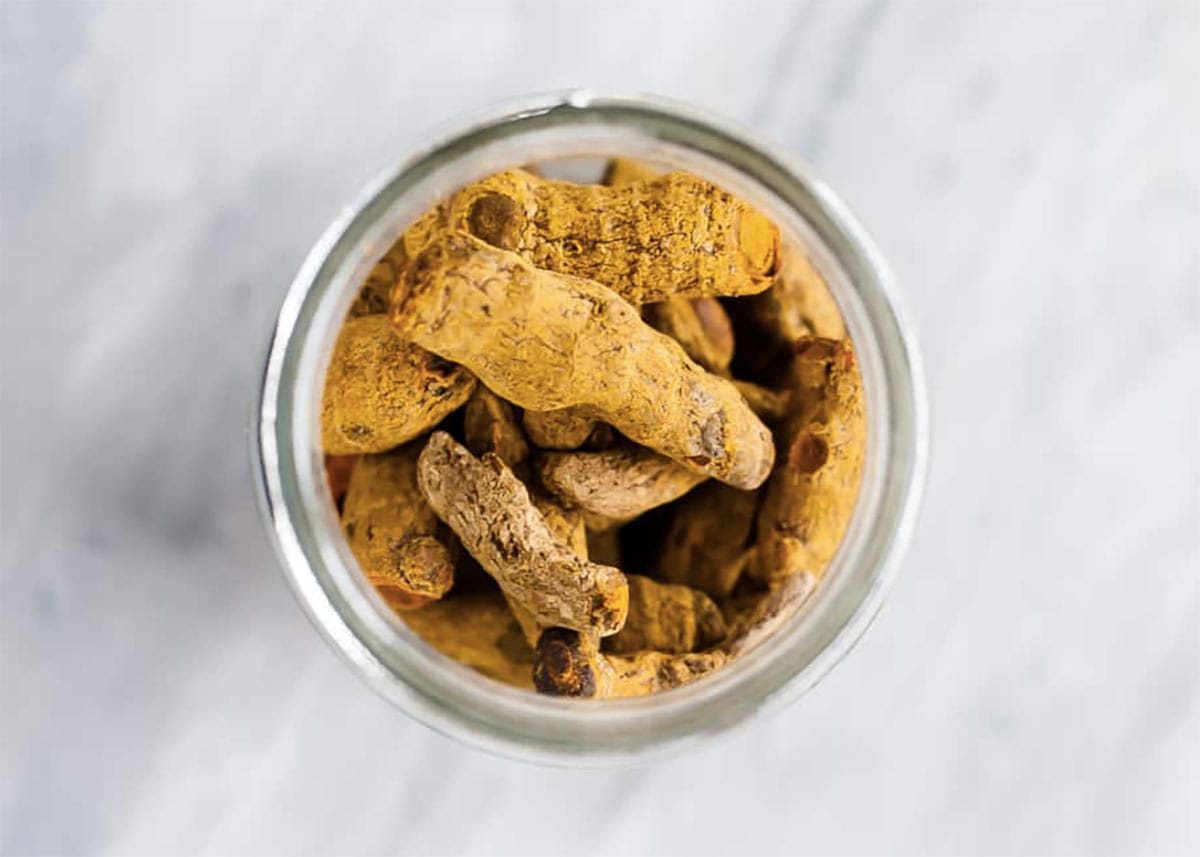
Despite its bright color that has a tendency to stain whatever it comes in contact with, turmeric actually works well in homemade face scrub recipes because it exfoliates and also helps even out your natural skin tone [source]. And by inhibiting an enzyme in your skin that produces pigment [source], turmeric may also lighten scars and other discolorations, making it helpful for acne-prone skin.
- ½ teaspoon turmeric
- 3 teaspoons almond milk
- 2 teaspoons baking soda
Instructions
Mix all ingredients together in a small bowl, and stir to combine. Using clean hands, massage over clean, damp skin with your fingertips, starting with your chin and working upward in small circles. Rinse and follow with moisturizer.
If you experience any skin discoloration from the turmeric, don't fret; it's not permanent! Rinse again with water or use a gentle cleanser (like this rice milk one) to remove any remaining yellow tint.
Why it works
Turmeric's texture provides excellent exfoliation. It’s also a potent anti-inflammatory with excellent wound-healing effects, and it helps fight unwanted bacterial pathogens [source].
And we all know sleep is essential for great skin. So if you're struggling to beat the blues and insomnia, try this soothing turmeric tea, perfect for sipping right before bed.
3. Calm Redness with Turmeric + Coconut Milk
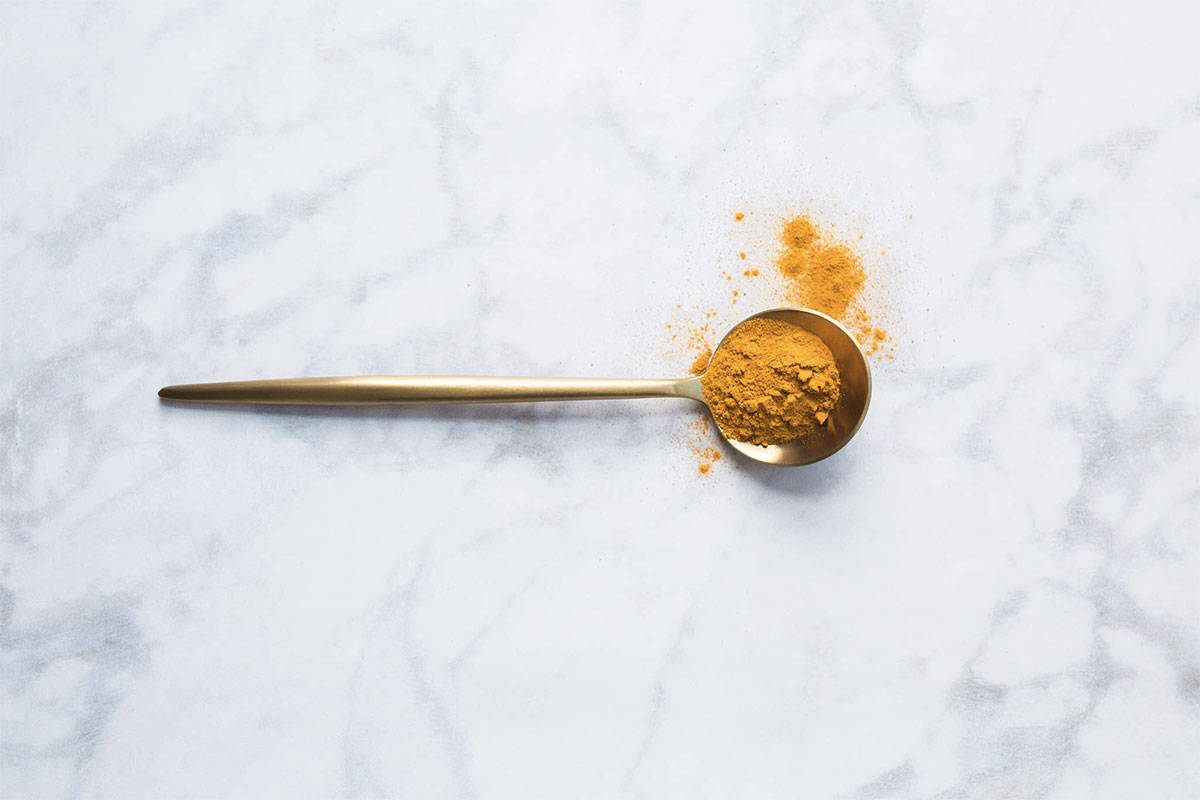
Combine turmeric with a little coconut milk and honey—and voila! An anti-inflammatory turmeric face mask that will calm skin prone to redness and irritation.
- 1-½ teaspoons ground turmeric
- 1 teaspoon raw organic honey
- 1 tablespoon coconut milk
Instructions
Put turmeric, honey, and coconut milk into a small bowl and stir. You want your mask to be a thin paste, so adjust the coconut milk as needed until you get the right consistency.
Cleanse your face to remove dirt and makeup then apply the mask evenly all over your face, being sure to focus on any inflamed areas. Leave the mask on for 20 minutes, then rinse off with warm water. Repeat 1-2 times a week until the inflammation subsides.
Why it works
Turmeric calms inflammation, soothes skin irritation, and treats burns [source]. Raw honey [source] and coconut milk [source] help tighten and brighten skin while also minimizing pores and replenishing moisture.
4. Beat Blemishes with Turmeric Essential Oil
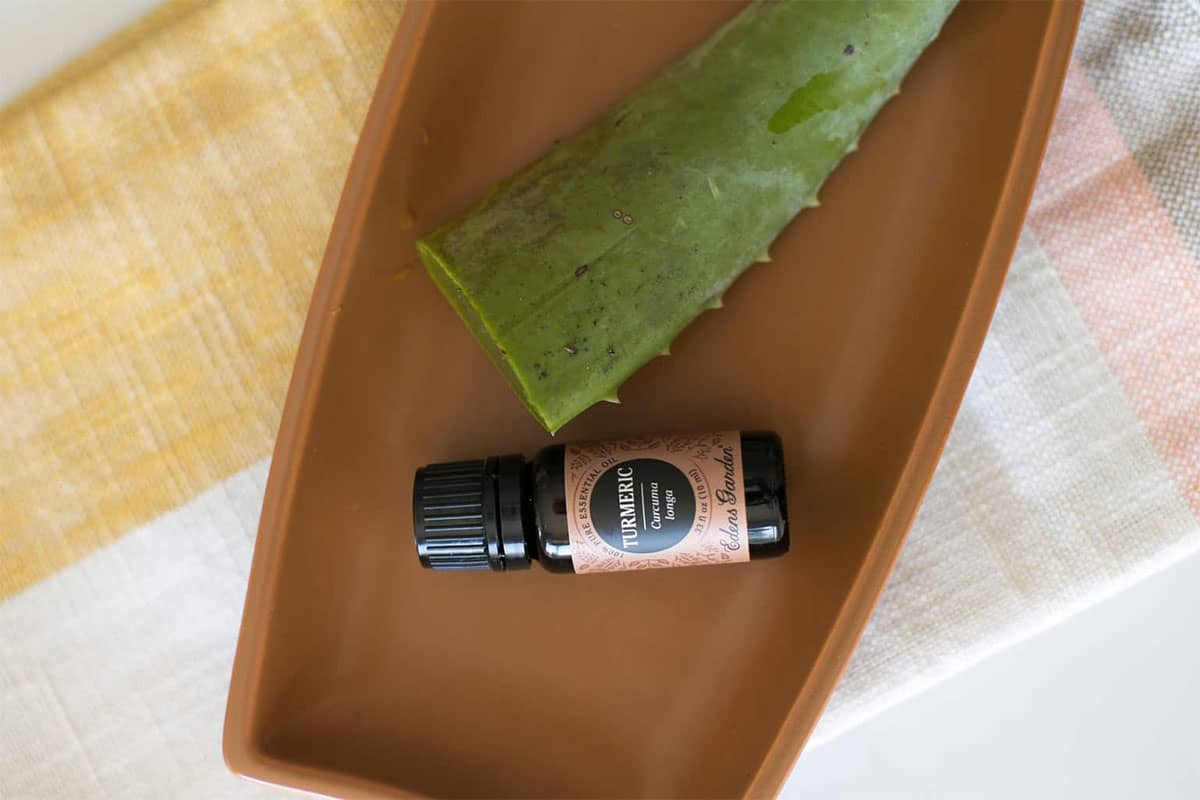
Jojoba oil is a non-comedogenic (meaning it won't clog pores) and lightweight carrier oil that closely resembles the skin's natural sebum. Turmeric essential oil combats acne-causing bacteria so when applied directly to blemishes, it can help reduce redness, swelling, and inflammation.
- 1-2 drops turmeric essential oil
- 1 teaspoon jojoba oil
Instructions
Dilute 1-2 drops of turmeric essential oil with jojoba oil and apply it directly to blemishes or dark spots for targeted skin benefits.
Why it works
Applying this mixture directly to blemishes or dark spots allows for precise treatment. Turmeric's anti-inflammatory and antibacterial properties are concentrated on the problem areas, providing faster relief and helping to fade dark spots left behind by acne.
5. Erase Discoloration with Turmeric + Yogurt
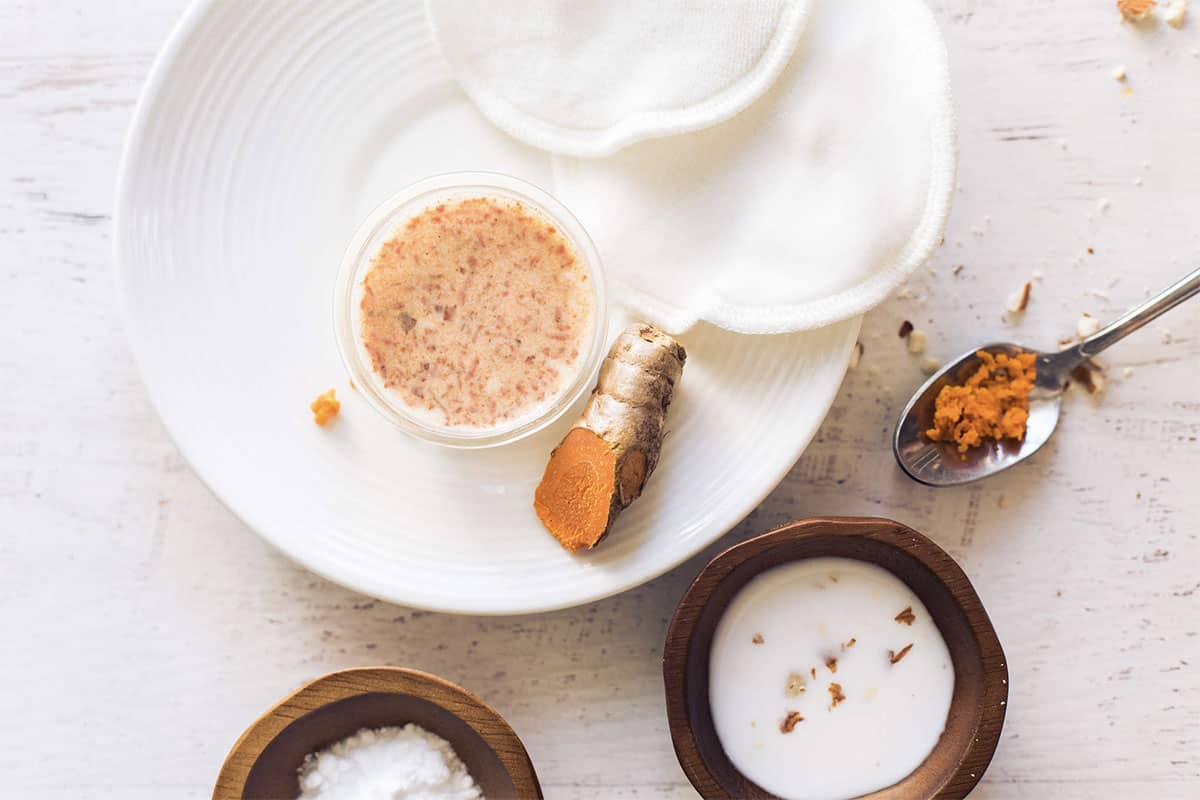
A face mask to reduce acne, improve skin tone, and leave your skin looking refreshed and rejuvenated. Lemon juice is rich in citric acid, which acts as a natural exfoliant, helping to unclog pores and lighten dark spots left by acne.
- ½ teaspoon turmeric powder
- 1 teaspoon fresh lemon juice
- 2 teaspoon plain yogurt (unsweetened)
Instructions
Assemble the turmeric powder, fresh lemon juice, and plain yogurt. Using clean fingertips or a brush, evenly apply the turmeric-lemon-yogurt mask to your face, focusing on acne-prone areas. Allow the mask to sit on your skin for 10-15 minutes then rinse your face with lukewarm water.
Why it works
Lemon juice helps exfoliate the skin, lighten dark spots, and provide a burst of vitamin C. Yogurt is known for its lactic acid content, which gently exfoliates and moisturizes the skin.
6. Zap Zits Overnight with Turmeric + Tea Tree
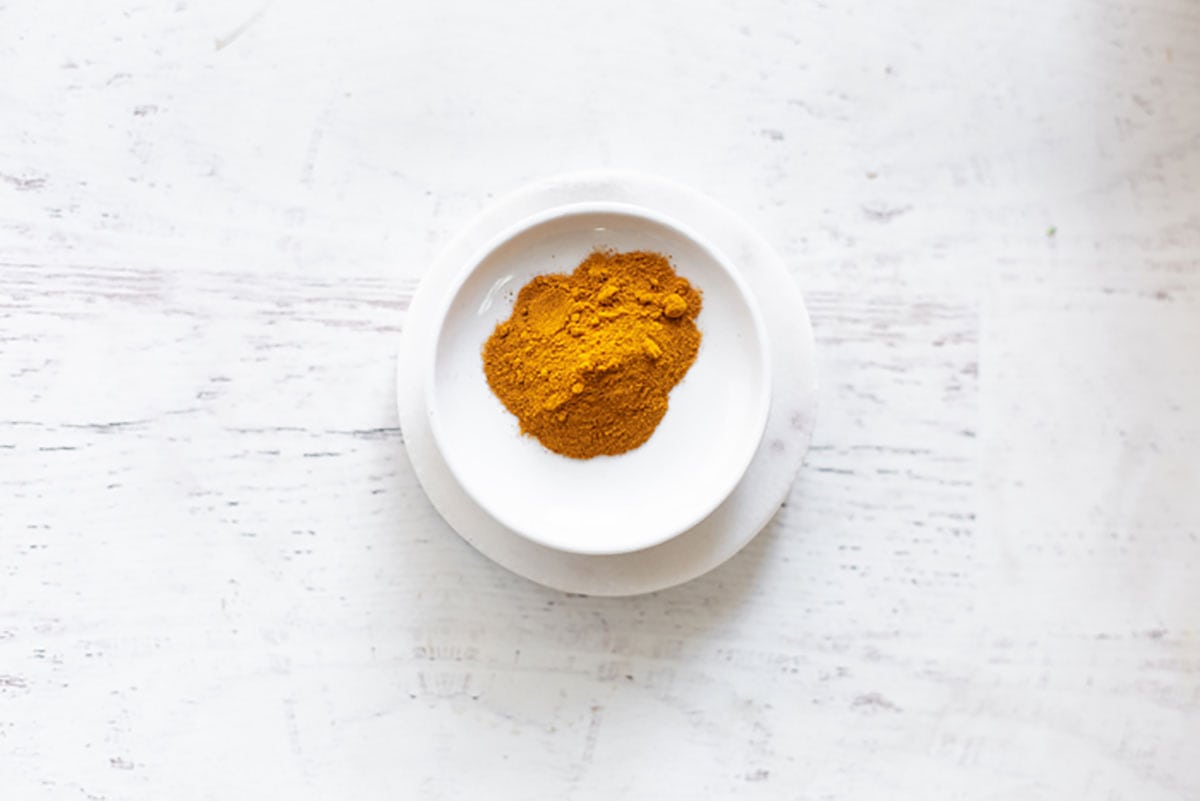
Rather than turn to harsh creams, apply a dab of turmeric for pimple flareups. It’s gentle, nourishing, and effective. Raw honey is praised for its antibacterial properties [source], so this sweet treatment will kill off the bacteria in zits.
This skin soother also calms swelling and redness and acts as a humectant to lock in moisture and plump skin. Combine naturally antiseptic and antibacterial turmeric [source] with honey to soothe inflamed skin and acne.
- 1 teaspoon raw honey
- Pinch ground turmeric
- 1 drop tea tree essential oil
Instructions
Combine the ingredients and leave the mixture on for 10 to 15 minutes before rinsing off. Or just dab on a bit of honey and let it sink in overnight, and then rinse it off in the morning. Continue to apply it nightly until the zit has disappeared.
Why it works
A dab of raw honey is a gentle, nourishing, and effective acne spot treatment. Raw honey is loaded with antioxidants, vitamins, and minerals [source], so it heals without aggravating the skin further. Plus, its antibacterial and anti-inflammatory effects make it an amazing remedy for breakouts.
7. Soothe Inflamed Skin with Turmeric + Aloe
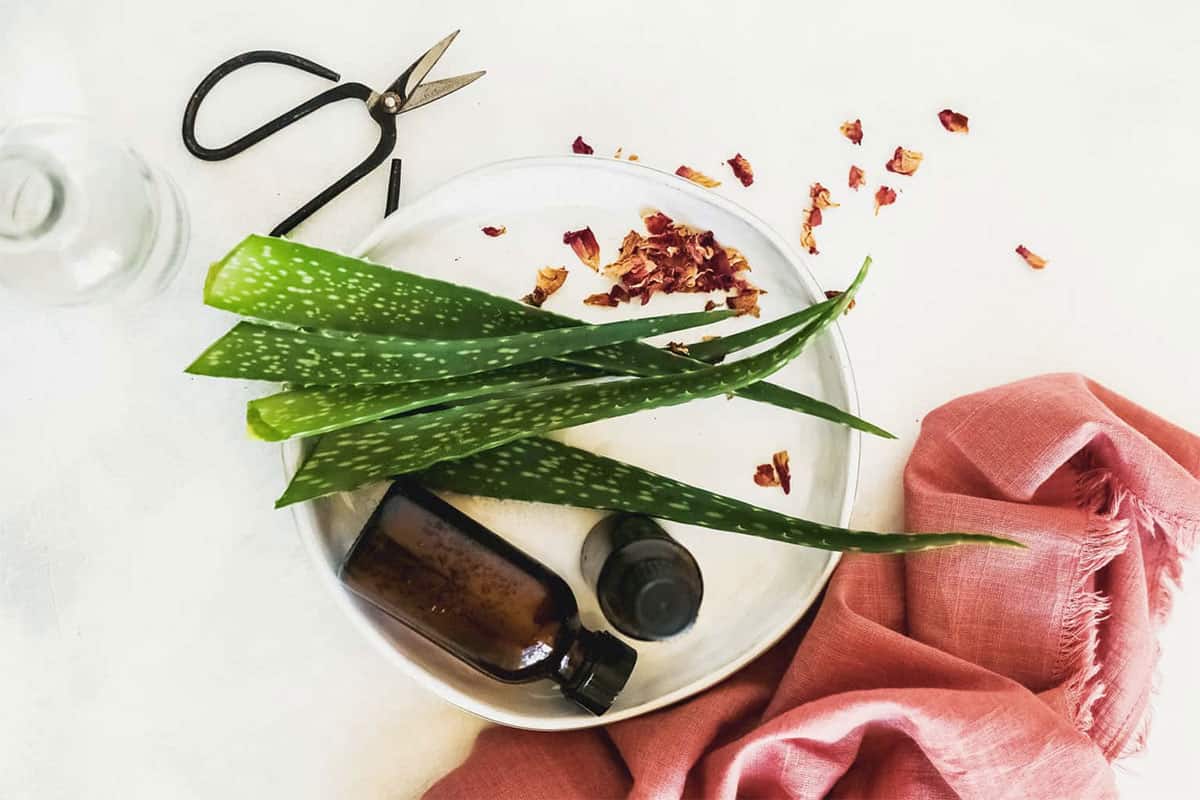
This soothing turmeric face mask for acne is great for calming irritated skin. Aloe vera gel provides a gentle, cooling effect, making it effective for acne-prone skin seeking relief and balance.
- ⅛ teaspoon turmeric powder
- 2 teaspoon aloe vera gel
Instructions
Combine turmeric powder with aloe vera gel. Apply the mixture to affected areas or the entire face. Leave it on for 15-20 minutes and rinse.
Why it works
Aloe vera helps soothe the skin, while turmeric's anti-inflammatory properties help reduce redness and inflammation.
8. Unclog Pores with Turmeric + Oatmeal
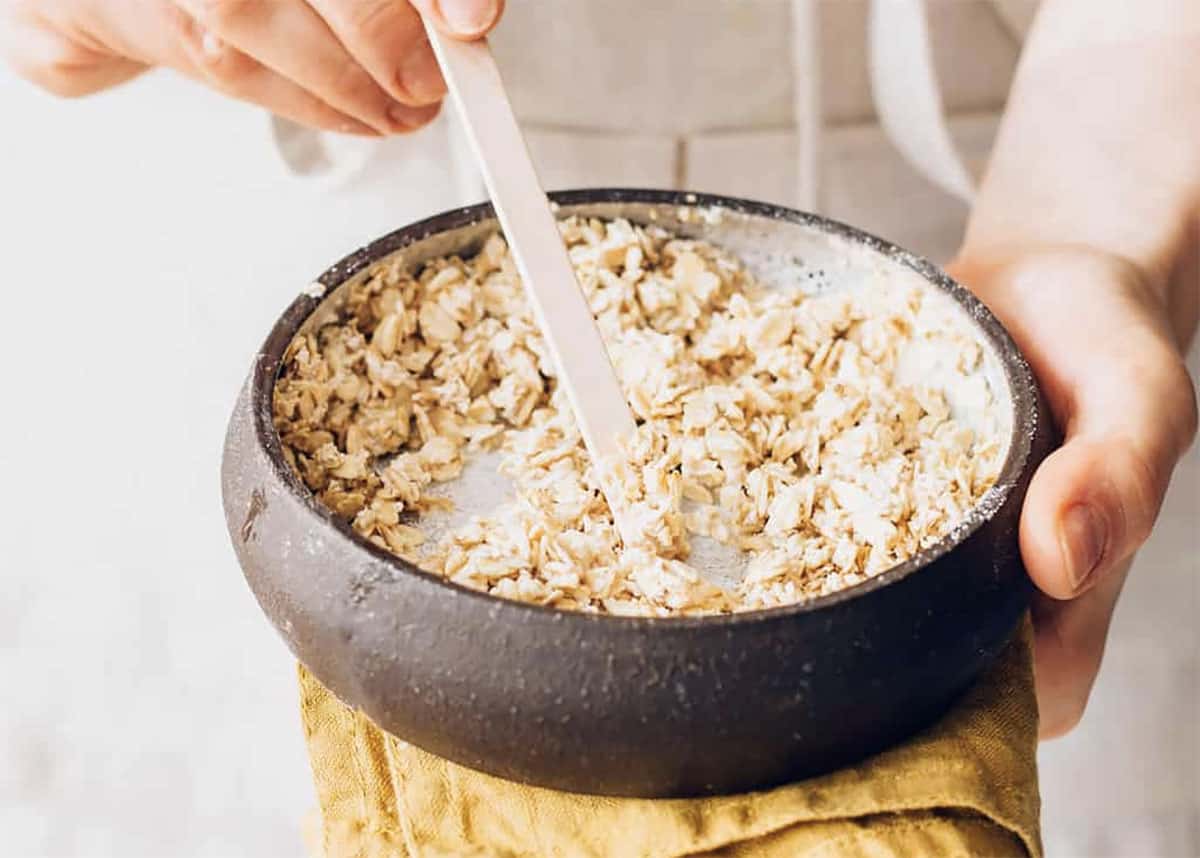
This exfoliating mask combines turmeric's anti-inflammatory properties with oats to provide gentle exfoliation to remove dead skin cells, unclog pores, and maintain a healthy complexion.
- ½ teaspoon turmeric powder
- 1 tablespoon finely ground oats
- Water
Instructions
Combine turmeric powder with finely ground oats and water to form a paste. Gently massage the mixture onto your face in a circular motion for exfoliation and acne prevention. Rinse thoroughly.
Why it works
Oats can help absorb excess oil and exfoliate dead skin cells.
9. Maintain Clear Skin with Turmeric + Neem Oil

Use this neem oil face mask once a week to reduce acne and maintain clear skin. Neem oil contains compounds like nimbidin and nimbin that have strong antibacterial properties to inhibit the growth of acne-causing bacteria. Plus, neem oil may promote faster wound healing to help reduce scarring.
- 1 teaspoon neem oil
- 1-2 tablespoons of clay
- ¼ teaspoon turmeric powder
- Water or aloe vera gel
Instructions
If your neem oil is not already diluted, mix it with a carrier oil, such as coconut or jojoba oil, at a 1:10 ratio (1 part neem oil to 10 parts carrier oil). This dilution is essential to avoid skin irritation, as neem oil can be potent.
In a clean, non-metallic bowl, combine clay with diluted neem oil. Slowly add water or aloe vera gel until you achieve a smooth paste consistency.
Use clean fingers or a brush to evenly apply the neem oil face mask to your face, focusing on areas prone to acne. Be cautious not to get the mixture in your eyes.
Allow the mask to sit on your skin for about 10-15 minutes or until it dries. Then rinse your face with lukewarm water, usingse gentle, circular motions while rinsing to exfoliate your skin.
Why it works
Turmeric's anti-inflammatory properties and neem's potent antibacterial qualities work to alleviate acne and reduce scarring.
References
Prasad S, et al. Turmeric, the golden spice. In: Herbal Medicine: Biomolecular and Clinical Aspects. Taylor & Francis; 2011:(Ch) 13.
Antigua E, et al. Acne: a new model of immune-mediated chronic inflammatory skin disease. G Ital Dermatol Venereol. 2015.
Peng Y, et al. Anti-inflammatory effects of curcumin in the inflammatory diseases: status, limitations and countermeasures. Drug Des Devel Ther. 2021.
Dai C, et al. The natural product curcumin as an antibacterial agent: current achievements and problems. Antioxidants. 2022.
Hewlings SJ, et al. Curcumin: a review of its’ effects on human health. Foods. 2017.
Aggarwal GG, et al. Potential therapeutic effects of curcumin, the anti-inflammatory agent, against neurodegenerative, cardiovascular, pulmonary, metabolic, autoimmune and neoplastic diseases. Int J Biochem Cell Biol. 2009.
McLoone P, et al. Honey: a therapeutic agent for disorders of the skin. Cent Asian J Glob Health. 2016.
Mandal MD, et al. Honey: its medicinal property and antibacterial activity. Asian Pac J Trop Biomed. 2011.
Carter DA, et al. Therapeutic Manuka honey: no longer so alternative. Front Microbiol. 2016.
Lee YB, et al. Potential role of the microbiome in acne: a comprehensive review. J Clin Med. 2019.
Hollinger JC, et al. Are natural ingredients effective in the management of hyperpigmentation? a systematic review. J Clin Aesthet Dermatol. 2018.
Smit N, et al. The hunt for natural skin whitening agents. Int J Mol Sci. 2009.
Vollono L, et al. Potential of curcumin in skin disorders. Nutrients. 2019.
This post was medically reviewed by Dr. Jennifer Haley, a board-certified dermatologist with extensive experience in medical, cosmetic, and surgical dermatology. Learn more about Hello Glow’s medical reviewers here. As always, this is not personal medical advice, and we recommend that you talk with your doctor.
243
